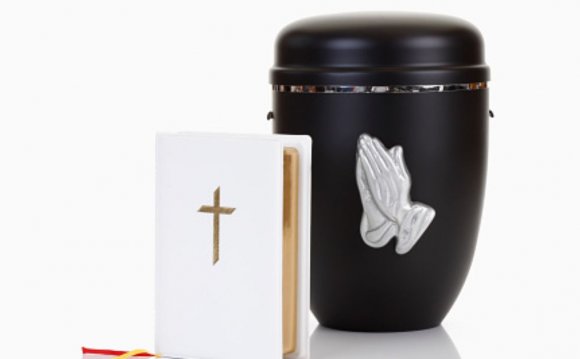
When a person has selected cremation and that process has been carried out, the ashes have a volume roughly that of a five pound sack of sugar. The bone fragments are pulverized to about kitty litter texture. Depending on the fuel and temperature used, they are somewhere between a light grey to white color. The word ashes is sort of a misnomer. Cremains (cremation + remains) is now the preferred and more accurate word. The funeral home or crematorium will make the cremains available in a cardboard box, a Tupperware-like container or an inexpensive plastic urn. You are expected to pick-up the container, unless you've made some other arrangement for their disposition.
The Tampa yellow-pages lists a cremation service for $345 with your survivors expected to pick up the cremains at the funeral home. This is a good price since it includes pickup of the deceased. However, if you want the cremains mailed to you, they charge you postage plus an additional $150! for a minimum urn which, in reality, probably costs $5. So if you plan to deal with a crematory directly, be prepared to pickup the cremains or pay an awful lot extra to have them mailed to you.
However, it should be noted that the funeral home currently associated with the Society includes the cost of a minimal urn in their Cremation price. You're still expected to pickup the urn at the funeral home, but they will mail it to you (or wherever) just for the cost of postage.
So, what are some of the options for disposing of the cremains?
Let the funeral home take care of it
Florida Statute 470.0255 specifies that cremated remains not retrieved by the responsible party within 120 days may be scattered at sea. There is no extra charge for this by the Society's contracted Funeral Home.
Scattering at sea for veterans
Scattering of cremains at sea is available to all veterans and dependents, and is provided by the Navy or Coast Guard. A flag is required, andif supplied by the familycan be returned. (The VA will give a flag to the family.) If supplied by the Navy, it will not be. Because sea burials are done at the convenience of the military, the family may not witness sea burial. The funeral home will charge postage to send the cremains to the nearest base.
Scattering by the survivors
All states, including Florida, allow the cremains to be given to the survivors for disposal. So far, I've heard of their being scattered on golf courses, in the lake behind the house, a favorite fishing spot, under the orange tree in the backyard, in a hole in the back yard, and among the foliage at Cypress Gardens. In Florida, it is illegal to scatter cremains in fresh water - but people do it. As for Cypress Gardens and the like, people take the container in a handbag or purse, and then, when no one is watching, scatter the cremains. If you plan to scatter them on water, don't forget to throw them downwind! A minor concern of scattering or burying the cremains on one's property is that they might become a constant, melancholy reminder that the person died. And I'm not sure what the feelings of a second spouse might be working around rose bushes where the cremains of the first spouse were scattered or buried.
Keep the cremains in an urn or nice box
As with caskets, funeral directors make a hugh profit on urns. It isn't necessary to put the cremains in an expensive urn. Unfortunately, some less-than-honest firms will tell survivors that they have to purchase a "temporary container" ($45+) if they haven't got an urn. This is to lead the survivors into buying an expensive urn. The survivors have the right to refuse such a purchase and can ask for the container that comes from the crematory.
Since the cremains are being saved to provide memories, it's really quite appropriate to put them in a container related to the decease's life. For example, a pretty vase, a fancy wine bottle, a terrarium, etc. would be suitable. If they are going to be visible, sea-shells can be mixed in for a nice look. If a child or grandchild does woodworking, perhaps they would like to make an attractive box.
Cremains are also "splitable". For example, if several of the children would like cremains for memory purposes, they can be divided up. Or the cremains could be divided so that a wife could be buried with both husband #1 and husband #2. Or they could be split so that half are buried in Florida, and the other half "up north".
Bury the urn on the property
Although this is a viable option, eventually the land is going to be sold. At that point it becomes rather difficult for family members to return and pay their respects to the deceased. And it might unknowingly be dug up to make way for a pool. Who knows?
Bury the urn in a cemetery
This is an attractive option where burial plots may already be owned, especially "up north". The urn can be sent to the cemetery or a family member for direct interment. Or it could be displayed there, along with memorabilia (pictures, service medals, awards, etc.), at a visitation or memorial service, before interment. Cemeteries usually have rules that allow three, or more, urns to be buried in one burial plot. The normal procedure is to use an auger to drill a hole four to six feet deep and about six inches in diameter. The urn is lowered on a double cord, which allows the cord to be retrieved. Then the hole is filled in. (If Funeral Director type services are required on the other end, do contact the Funeral Association there to locate the recommended one.)
Bury the urn with the spouse
A variation of burying the urn is to keep it until the spouse dies and then mix the cremains into one urn for burial (or scattering), bury both urns at the same time, or put the urn in the casket of the second to die.
Inter the cremains in a Columbarium
Columbariums have become the way to inter cremains, particularly at National Cemeteries. A columbarium looks very much like the book shelves in a library, except they're made out of stone. There is normally ivy, paths, benches and trees which makes it a very serene setting. Usually there are five or six niches vertically and twenty or thirty sets of these horizontallya bit like mail boxes in a post office lobby. The niches themselves are about 10 inches wide, 12 inches high and 15 inches deep. A small curtain is put in the opening for the duration of the service and closed after the last prayer. Later, a stone cover, with the name(s) and dates is semi-permanently attached to the front of the niche. Almost all niches can hold at least two urns or box-like containers. Some can hold even more.
YOU MIGHT ALSO LIKE







